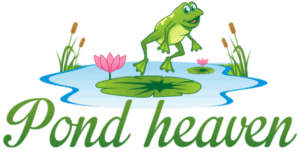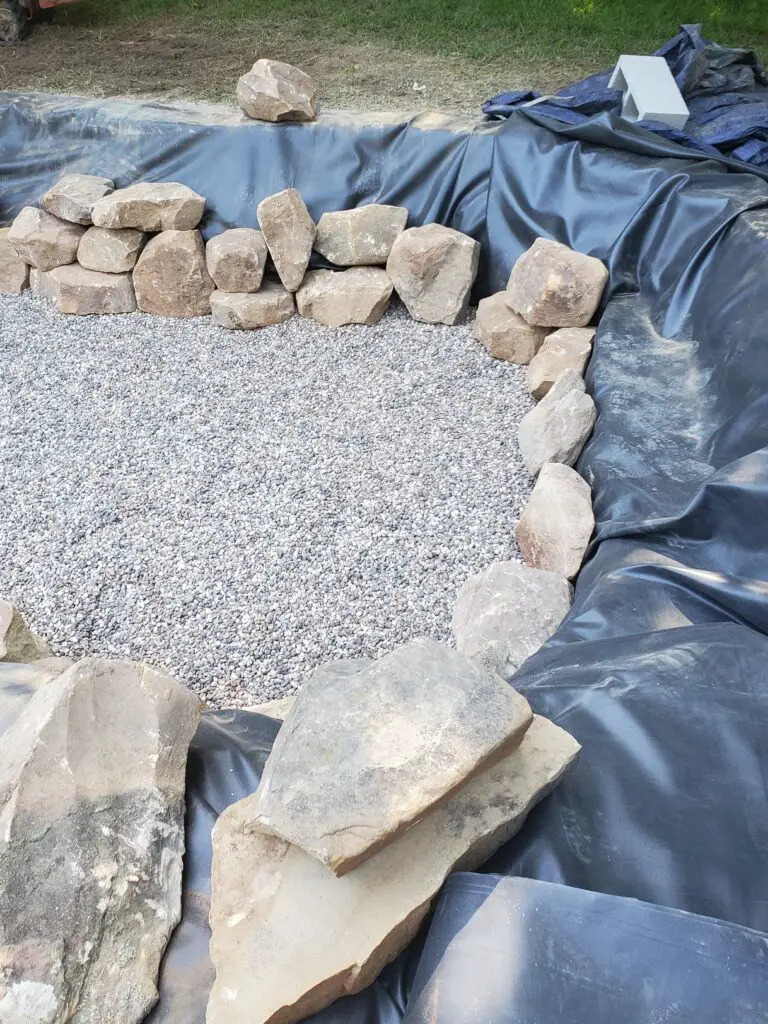
After digging a hole in the ground for your new koi pond, the next step is installing a pond liner. The liner is what keeps water inside the pond and stops it from leaching out through the base of the pond. It is critical to install a pond liner correctly because mistakes can be disastrous!
Lay a protective under liner beneath the pond liner to keep it from being damaged. Lay the pond liner down as smoothly as possible. The pond liner must extend at least 3 feet outside of the pond’s edge so that you can secure it in place. Use rocks to weigh it down along the edges and the bottom.
There are different types of liners available for ponds in a range of materials. Do some research before you go pond liner shopping. If you have never installed a pond liner before, you are in the right place! Here, we take you through the things you need to know to successfully line your new koi pond.
Pro Tip: If you’re tired of wasting money and making costly mistakes on the koi-keeping hobby or are thinking about buying koi fish but don’t know where to start, I strongly suggest you check out this ebook. I recently read this ebook, and it contains SO much useful information, such as:
- 3 proven steps to identify koi fish diseases
- WARNING: 3 things you should NEVER do when it comes to caring for koi
- When to seek professional help when it comes to looking after your koi
How To Line A Koi Pond With A Flexible Liner
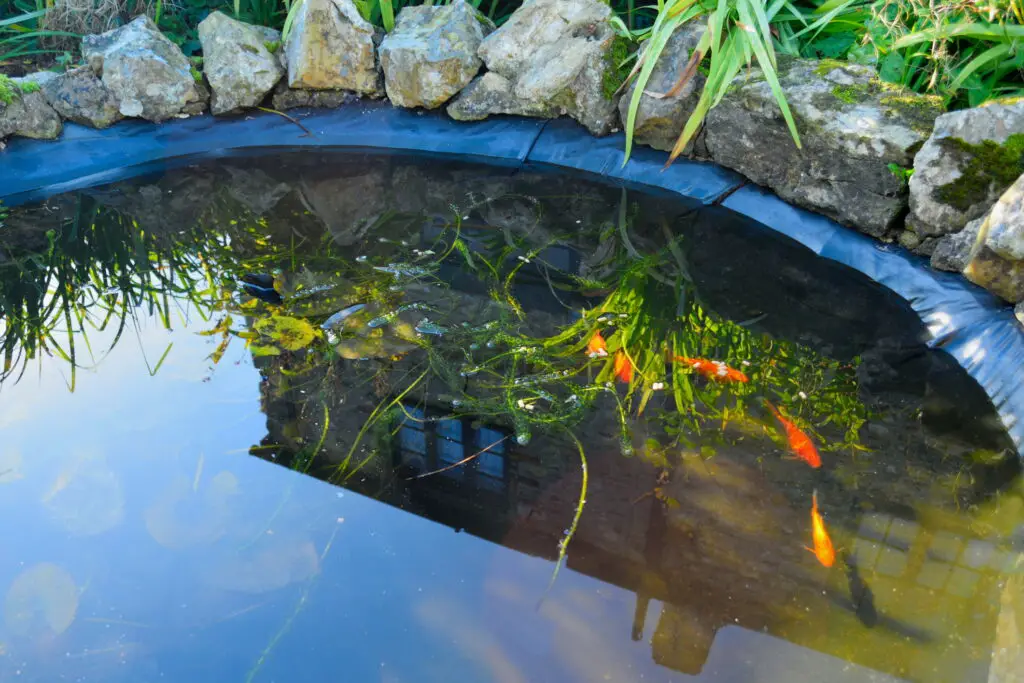
It is very straightforward to build a koi pond using a flexible pond liner. You do not need to pay someone to do it for you. It is the perfect weekend project.
You have to know the exact size and shape of your pond when you buy the liner. The liner should be larger than the area of the pond to allow some overlap.
It helps to spray paint the shape of the pond onto the ground so that you know where to dig. Dig the hole so that the sides slope gently inwards. Remove any sharp roots or pointy rocks from the hole.
Line the hole with a rubber or plastic underlay. Have two people help you to roll the sheet out over the pond. Make sure it extends about 3 feet past the edges of the pond so that you can use rocks, soil, or pavers to secure it.
Try to lay the underlay sheet down as smoothly as possible. The pond liner itself is laid down next.
If the pond liner is prefabricated, simply have a few people help you lower it into the hole. If it is just one solid piece, get help to roll it out over the pond. The pond liner also has to extend past the edges of the pond, about 3 feet.
Make neat folds and pleats to smooth the liner down. Get it to mold to the shape of the pond. If there is a waterfall, the liner should extend beyond the feature.
Next, use heavy rocks to weigh down the liner around the edges of the pond. You may need to use some rocks inside the pond too.
Once your liner is installed, you can install a waste filtration system, and then the pond is ready to be filled with water!
You can leave the pond liner exposed so that the koi pond looks deep and black. Koi fish display beautifully against a black background. For a more natural-looking pond, add gravel and rocks to the bottom of the pond.
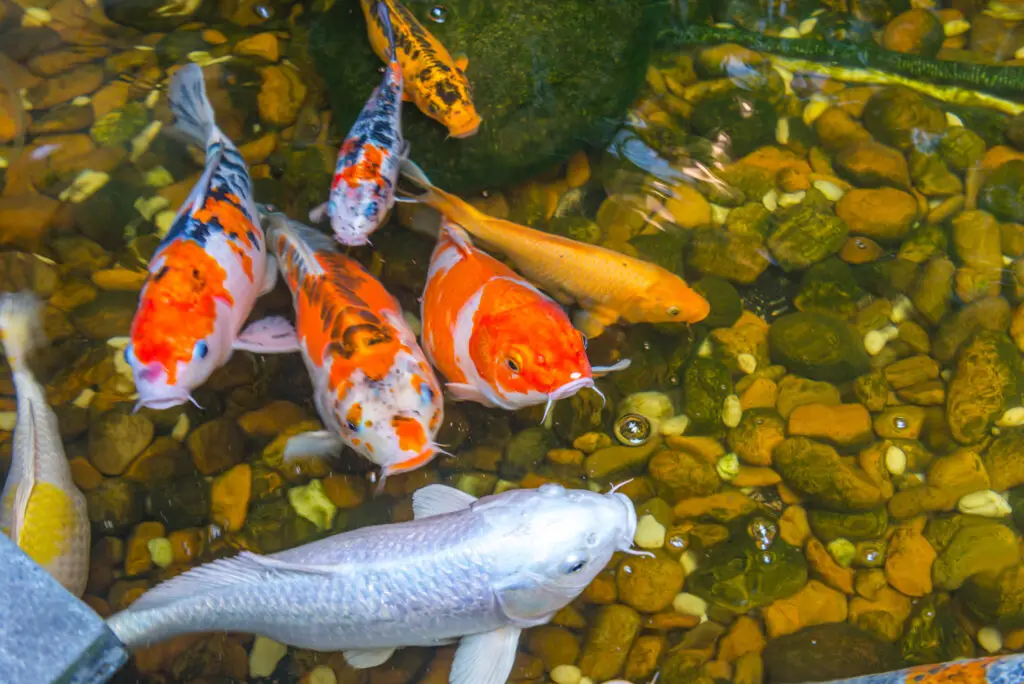
How To Line A Koi Pond With A Rigid Pond Liner
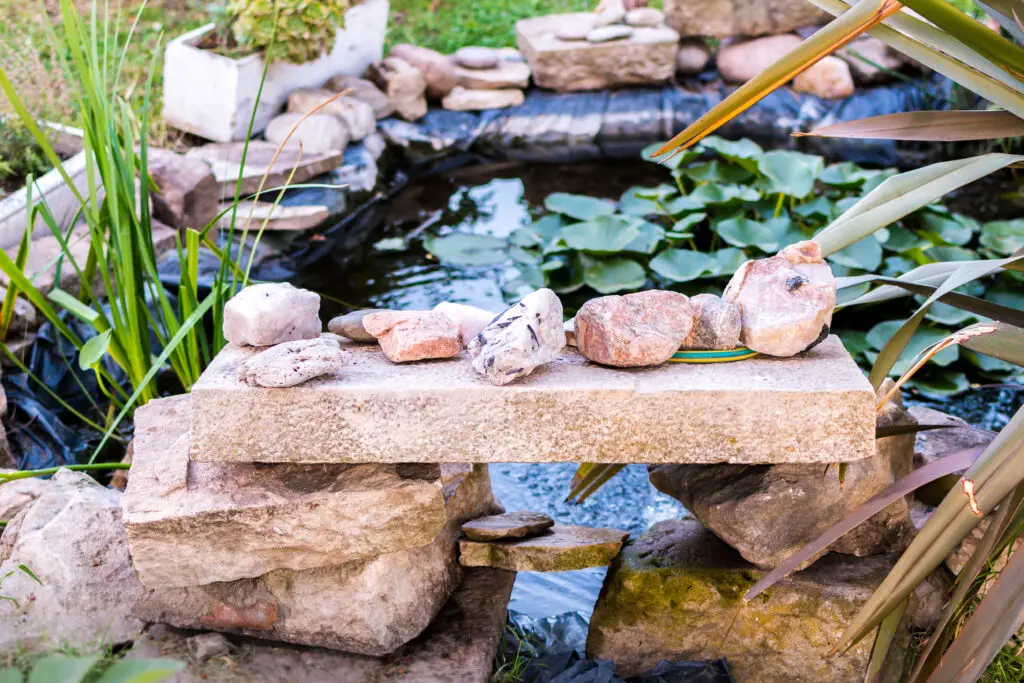
Lining a koi pond with a rigid liner is very easy because it is a smaller, more manageable shape, and you do not have to worry about getting the liner to lie smoothly.
The shape of the hole you dig does not have to match the shape of the rigid liner exactly. Just dig the hole so that it is as deep and as wide as the rigid liner.
Place the liner into the hole and backfill the hole with the soil you dug out. Tamp the edges down so that the rigid liner fits snugly.
Use rocks around the edges of the pond to hide the pond liner and weigh down the edges further. You can leave the bottom of the pond exposed or add a layer of gravel and rocks to the pond for a more natural look.
Once you have installed a waste filtration system and an aerator, you can fill your new pond with water!
Types Of Liners For Koi Ponds
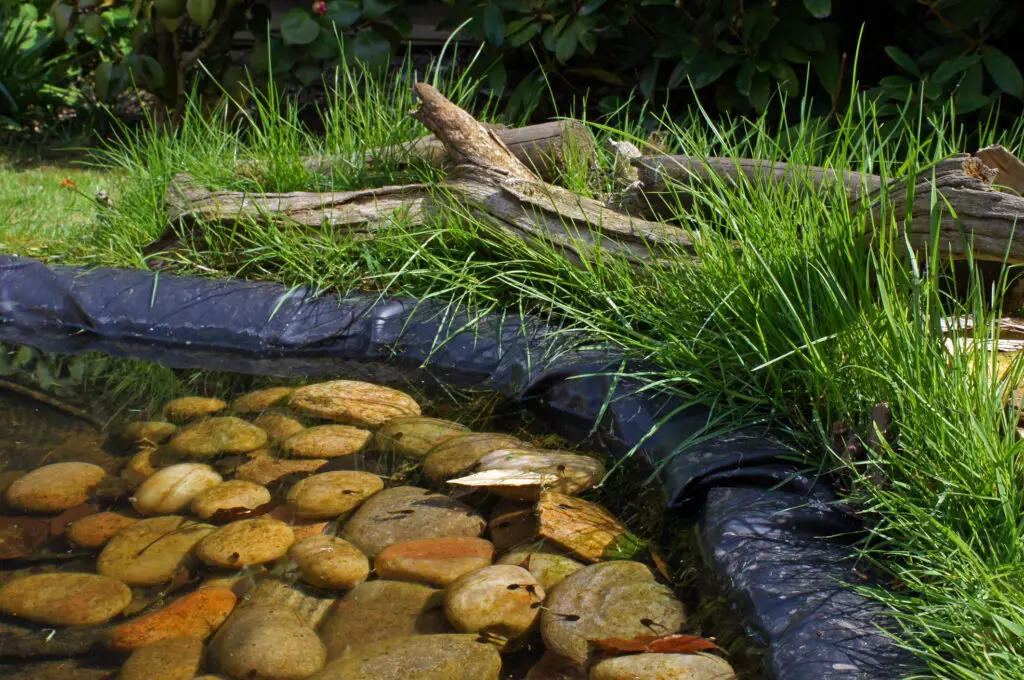
Pond liners come in many different materials, but they all fit into one of two categories: rigid or flexible.
Rigid Pond Liners
Rigid pond liners are pre-shaped and made from recycled polyethylene, reinforced PVC, or fiberglass (materials that are non-toxic to fish). They come in a variety of shapes.
Pre-formed pond liners limit the size of the pond, as the largest available ones can only hold around 260 gallons of water. Therefore, you cannot keep many koi fish in a pre-formed pond.
Most hardware stores stock pre-formed rigid pond liners. They are easy to install. Rigid pond liners last for many years as they are not easily punctured by tree roots or falling rocks, and they are UV resistant.
Flexible Pond Liners
Flexible pond liners are synthetic geotextiles. They enable you to build much larger ponds because you can join liner sheets together.
Flexible pond liners come in a variety of materials, like butyl rubber, PVC, high-density polyethylene (HDPE), linear low-density polyethylene (LLDPE), flexible polypropylene (FPP), or reinforced polyethylene (RPE).
Only some of these types of pond liners are suitable to use with koi ponds!
Flexible pond liners vary in thickness from 0.10mm to 2mm. The ideal thickness for a koi pond is around 0.5 to 0.75mm.
One drawback of flexible pond liners is that they are easily ripped and punctured. Sharp rocks, tree roots, and angular objects can tear the liner during installation. This is why it is important to use a pond underlay.
Some materials are more resistant to tearing and are UV stabilized, so they will not disintegrate if exposed to sunlight. Some liners are better for cold climates because the material can withstand freezing and thawing.
You can buy custom prefabricated box-welded pond liners. These make for the easiest installation and line a pond most smoothly. But they are more expensive.
The other option is buying sheets of liner material, cutting it to the right sizes, and heat sealing the seams together. This must be done with some measure of precision and can be tricky!
What Is The Worst Koi Pond Liner Materials?
Choosing the right pond liner for your new koi pond is crucial to avoid problems with pond maintenance and management further down the line.
Avoid using the following types of pond liners for koi ponds:
- 0.5mm PVC pond liner – this is the cheapest type of liner available and is widely used, but it has many disadvantages. It becomes very brittle and easily tears in cold temperatures. Not all flexible PVC is fish friendly. Some contain toxic plasticizers that leach into the water.
- HDPE – this material is very heavy and stiff, making it difficult to work with, especially in smaller ponds. It easily scratches and gets stress fractures.
- LLDPE – because this material does not have good UV resistance, it breaks down when exposed to sunlight. It is not durable.
- EDPM – not all EDPM is safe for fish. Some types contain toxic chemicals that leach into the water. Not all EDPM is UV resistant, and it breaks down quickly if exposed to sunlight.
The Best Pond Liners For Koi Ponds
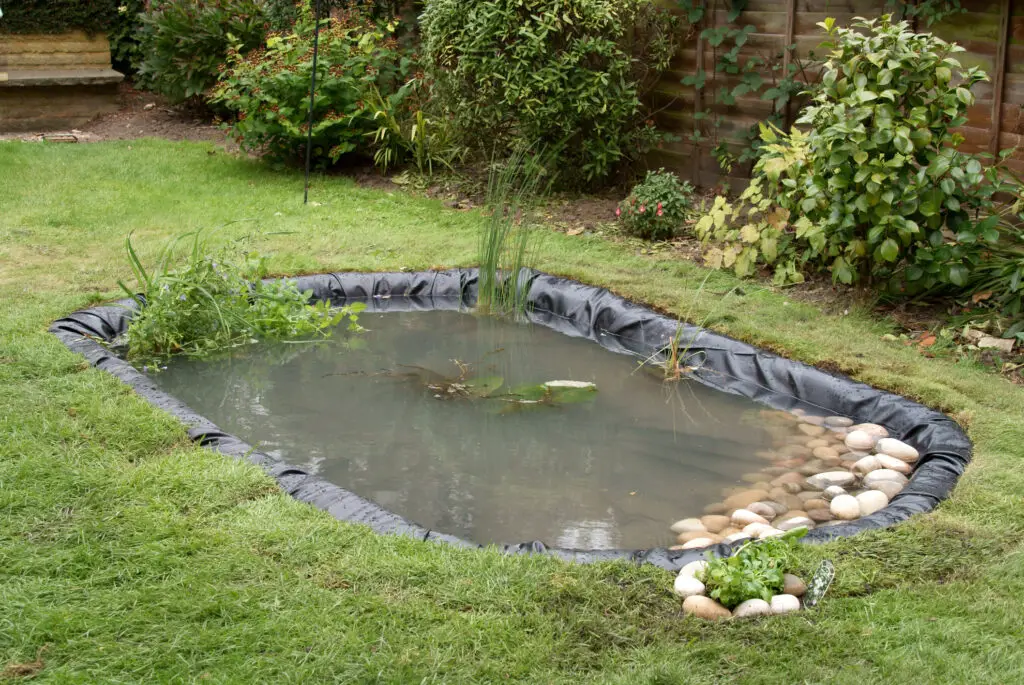
The best materials to use for lining a koi pond are:
- Synthetic rubber – durable, flexible, and easy to work with. It is safe for koi fish. UV resistant and can cope with freezing temperatures. Care must be taken during installation, and an underlay must be used as this material is vulnerable to punctures and tears.
- RPE – resistant to tearing, flexible, light, and easy to install. It is also UV resistant, so it is durable, even if left exposed.
What Color Pond Liner Should You Get For A Koi Pond?
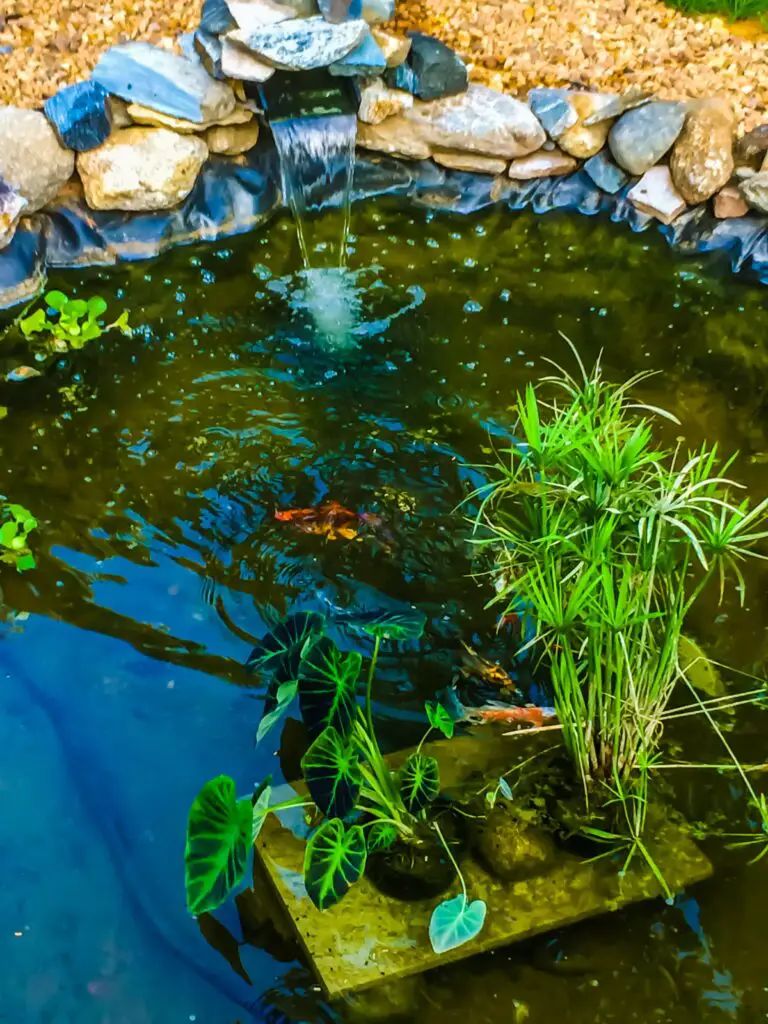
Most pond liners are black, but if you want the bottom of your pond to be a different color, it is possible to buy liner material in shades other than black.
Gray or tan pond liners are popular. People use them to mimic the colors of natural limestone, granite, slate, or shale. Using a gray or tan pond liner helps the pond blend into its surroundings and gives it a beautiful natural look.
White pond liners are used for very formal koi ponds. Algae and debris show up against a white background very easily, so if you go with this option, be aware that you will have to work extra hard to keep your pond spotlessly clean!
Oddly, blue is a popular color for koi ponds. In Japanese koi competitions, the fish are always judged in blue tanks or tubs.
Koi fishes’ brilliant colors display most clearly against a blue background. If you want to see your koi in the best possible light, choose a pond liner in competition blue!
How To Hide A Pond Liner
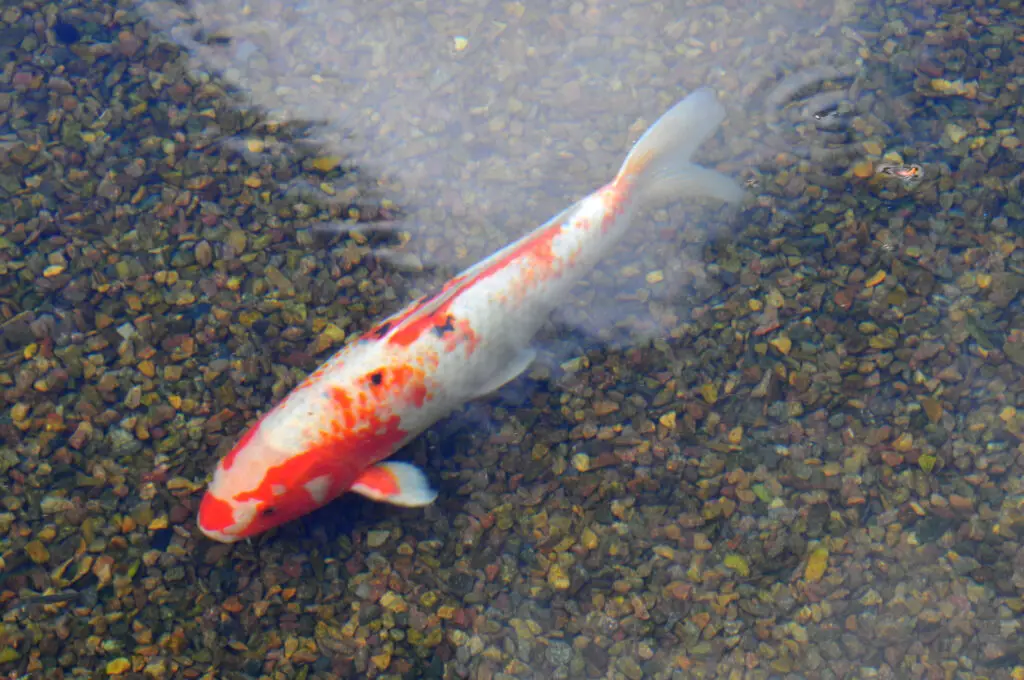
It is perfectly fine to leave the pond liner exposed, but many people add a layer of gravel on top of the pond liner to hide it. While it is not strictly necessary, there are many advantages to putting a thin layer of gravel at the bottom of a fish pond:
- Gravel provides a surface for beneficial nitrifying bacteria to grow. The bacteria help to convert toxic ammonia in the water to non-toxic nitrates. They also break down organic debris that falls to the bottom. These bacteria will also grow on a black pond liner, but by adding gravel, you can increase the amount of surface area for the microbes.
- Keeps sludge from building up on the bottom of the pond.
- A gravel pond bottom looks more natural than a black pond bottom.
- It makes pond maintenance easier and safer when you have to step into the pond. Without gravel, it can be very slippery.
- Gravel shields the pond liner from direct sunlight, helping it last longer. Even the most UV-resistant materials will break down over time.
What Are The Benefits Of A Natural Pond Bottom?

A pond liner does not have to be a synthetic material! Earthen ponds are gaining popularity as a waste-free alternative to synthetically lined ponds.
Clay is used to line the bottoms of earthen ponds. Because the particles in clay are so small, they can be compacted so well that it is watertight.
Building a koi pond with a natural clay bottom is more expensive and a bit more difficult than using a plastic liner. The layer of compacted clay must be about a foot thick.
Small earthen bottom ponds are impractical. This method of lining a pond is only practical for large ponds.
All the best koi farms raise and keep their fish in natural mud ponds. There are several advantages to keeping koi in a pond with a natural bottom:
- Fish grow larger, healthier, and their colors are more vibrant.
- The minerals and micronutrients in the mud are good for fish’s immune systems.
- Koi are more resistant to pests and diseases.
- More sustainable than rubber or plastic liners that break down over time
The only drawback to natural ponds is that the water does not stay crystal clear. You cannot see the koi all the time because they stir up sediment. The koi like living in muddy water, but this type of pond is not to everyone’s taste!
Conclusion
Lining a koi pond is essential for keeping the pond water contained. Without a waterproof barrier, the pond water would simply seep away into the soil. Installing a pond liner is very easy for small ponds, and with the help of some friends, you can line large ponds yourself. Synthetic rubber, or RPE, is the best material for a flexible pond liner. Rigid pond liners molded from plastic or fiberglass are also available.
Before laying the pond liner down, line the pond with an underlay. This will protect the pond liner from being punctured by sharp rocks or roots. Lay the pond liner down as smoothly as possible and make sure all seams are heat-sealed. The liner must extend past the edge of the pond so that you can secure it with soil and rocks.
Resources
https://www.btlliners.com/what-pond-liners-are-best-for-koi-ponds
https://www.wikihow.com/Build-a-Koi-Fish-Pond#Constructing-the-Pond
https://splashsupplyco.com/should-i-put-gravel-on-the-bottom-of-my-koi-pond/
